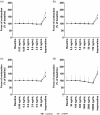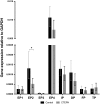Prostacyclins have no direct inotropic effect on isolated atrial strips from the normal and pressure-overloaded human right heart
- PMID: 28597773
- PMCID: PMC5467920
- DOI: 10.1177/2045893217691532
Prostacyclins have no direct inotropic effect on isolated atrial strips from the normal and pressure-overloaded human right heart
Abstract
Prostacyclins are vasodilatory agents used in the treatment of pulmonary arterial hypertension. The direct effects of prostacyclins on right heart function are still not clarified. The aim of this study was to investigate the possible direct inotropic properties of clinical available prostacyclin mimetics in the normal and the pressure-overloaded human right atrium. Trabeculae from the right atrium were collected during surgery from chronic thromboembolic pulmonary hypertension (CTEPH) patients with pressure-overloaded right hearts, undergoing pulmonary thromboendarterectomy (n = 10) and from patients with normal right hearts operated by valve replacement or coronary bypass surgery (n = 9). The trabeculae were placed in an organ bath, continuously paced at 1 Hz. They were subjected to increasing concentrations of iloprost, treprostinil, epoprostenol, or MRE-269, followed by isoprenaline to elicit a reference inotropic response. The force of contraction was measured continuously. The expression of prostanoid receptors was explored through quantitative polymerase chain reaction (qPCR). Iloprost, treprostinil, epoprostenol, or MRE-269 did not alter force of contraction in any of the trabeculae. Isoprenaline showed a direct inotropic response in both trabeculae from the pressure-overloaded right atrium and from the normal right atrium. Control experiments on ventricular trabeculae from the pig failed to show an inotropic response to the prostacyclin mimetics. qPCR demonstrated varying expression of the different prostanoid receptors in the human atrium. In conclusion, prostacyclin mimetics did not increase the force of contraction of human atrial trabeculae from the normal or the pressure-overloaded right heart. These data suggest that prostacyclin mimetics have no direct inotropic effects in the human right atrium.
Keywords: Prostacyclin; chronic thromboembolic pulmonary hypertension (CTEPH); contractility; prostanoid receptors; right heart.
Figures





Similar articles
-
Inotropic Effects of Prostacyclins on the Right Ventricle Are Abolished in Isolated Rat Hearts With Right-Ventricular Hypertrophy and Failure.J Cardiovasc Pharmacol. 2017 Jan;69(1):1-12. doi: 10.1097/FJC.0000000000000435. J Cardiovasc Pharmacol. 2017. PMID: 27652910
-
A comparative study of PGI2 mimetics used clinically on the vasorelaxation of human pulmonary arteries and veins, role of the DP-receptor.Prostaglandins Other Lipid Mediat. 2013 Dec;107:48-55. doi: 10.1016/j.prostaglandins.2013.07.001. Epub 2013 Jul 12. Prostaglandins Other Lipid Mediat. 2013. PMID: 23850788
-
Vasoactive intestinal peptide has a direct positive inotropic effect on isolated human myocardial trabeculae.Clin Sci (Lond). 2001 Dec;101(6):637-43. doi: 10.1042/cs20010076. Clin Sci (Lond). 2001. PMID: 11724651
-
Cost effectiveness of prostacyclins in pulmonary arterial hypertension.Appl Health Econ Health Policy. 2012 May 1;10(3):175-88. doi: 10.2165/11630780-000000000-00000. Appl Health Econ Health Policy. 2012. PMID: 22452448 Review.
-
The mechanistic basis of prostacyclin and its stable analogues in pulmonary arterial hypertension: Role of membrane versus nuclear receptors.Prostaglandins Other Lipid Mediat. 2015 Jul;120:56-71. doi: 10.1016/j.prostaglandins.2015.04.007. Epub 2015 Apr 23. Prostaglandins Other Lipid Mediat. 2015. PMID: 25917921 Review.
Cited by
-
Mitochondrial and Contractile Function of Human Right Atrial Tissue in Response to Remote Ischemic Conditioning.J Am Heart Assoc. 2018 Aug 7;7(15):e009540. doi: 10.1161/JAHA.118.009540. J Am Heart Assoc. 2018. PMID: 30371229 Free PMC article.
-
Pulmonary Hypertension-Associated Right Ventricular Cardiomyocyte Remodelling Reduces Treprostinil Function.Cells. 2023 Dec 4;12(23):2764. doi: 10.3390/cells12232764. Cells. 2023. PMID: 38067192 Free PMC article.
-
The Acute Effects of Prostacyclin on Right Ventricular Contractility and Pulmonary Artery Coupling.Am J Respir Crit Care Med. 2023 Apr 15;207(8):1100-1102. doi: 10.1164/rccm.202210-1861LE. Am J Respir Crit Care Med. 2023. PMID: 36689755 Free PMC article. No abstract available.
-
Advances in targeted therapy for chronic thromboembolic pulmonary hypertension.Heart Fail Rev. 2019 Nov;24(6):949-965. doi: 10.1007/s10741-019-09798-x. Heart Fail Rev. 2019. PMID: 31044326 Review.
-
Efficacy of treprostinil in the SU5416-hypoxia model of severe pulmonary arterial hypertension: haemodynamic benefits are not associated with improvements in arterial remodelling.Br J Pharmacol. 2018 Oct;175(20):3976-3989. doi: 10.1111/bph.14472. Epub 2018 Sep 16. Br J Pharmacol. 2018. PMID: 30098019 Free PMC article.
References
-
- Vonk-Noordegraaf A, Haddad F, Chin KM, et al. Right heart adaptation to pulmonary arterial hypertension: physiology and pathobiology. J Am Coll Cardiol 2013; 62(Suppl. 25): D22–D33. - PubMed
-
- Andersen S, Schultz JG, Andersen A, et al. Effects of bisoprolol and losartan treatment in the hypertrophic and failing right heart. J Card Fail 2014; 20: 864–873. - PubMed
LinkOut - more resources
Full Text Sources
Other Literature Sources

